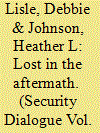|
|
|
Sort Order |
|
|
|
Items / Page
|
|
|
|
|
|
|
| Srl | Item |
| 1 |
ID:
164284


|
|
|
|
|
| Summary/Abstract |
What happens when violence disappears? What is left in the backwash of crisis? Who attends to the emotional, material and ideational detritus of closing borders? Like many, we are working in the aftermath of the recent and deadly intensification of EU migration. We contest the widespread account that the ‘crisis’ is now over – that policymakers have effectively ‘solved’ the problem of migration by gathering undocumented subjects into infrastructures of containment. We focus instead on the painful traces of EU migration that continue to be produced by global structures of citizen/alien, legal/illegal, friend/enemy. We do not produce a comprehensive diagnosis, normative argument or critical framework. Instead, we rest awhile in the aftermath of the crisis – specifically on the Greek island of Kos – to think about questions of abandonment, erasure and displacement. This is a visual essay representing a conversation between two researchers as they interact with the aftermath of the refugee crisis on Kos. Reflecting on select images from September 2016, we present a dialogue that directly speaks to a core theme each image raises. In doing so, we question some of the basic assumptions about how to do critical analysis on migration, security and borders, and therefore seek to disrupt dominant modes of academic writing as well as the practice of research itself.
|
|
|
|
|
|
|
|
|
|
|
|
|
|
|
|
| 2 |
ID:
099981


|
|
|
|
|
| Publication |
2010.
|
| Summary/Abstract |
Engaging with the literature on visual representations of human suffering, being a witness, and trauma, this article discusses visual representations of the 1994 genocide in Rwanda, and especially the art photography of Alfredo Jaar, Robert Lyons, and Jonathan Torgovnik of the aftermath of the genocide. It explores the conditions in which photography can succeed in disrupting stereotypical political interpretations of the killings. Art photography, it is argued, may help transform the viewers from being consuming spectators into being participant witnesses who self-critically reflect upon their own subject positions in relation to the conditions depicted in the image. By discussing photography of the aftermath of the genocide, the article acknowledges the unrepresentability of genocide; by focusing on visual representations, it reflects the extent to which political space is nowadays constituted by means of images; by concentrating on Rwanda, it contributes to the necessary process of examination and self-examination in connection with the killings.
|
|
|
|
|
|
|
|
|
|
|
|
|
|
|
|
|
|
|
|
|